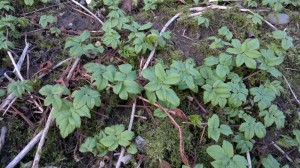Ground elder – Identification, distribution, edibility.
Aegopodium podagraria
- Edibility -3/5 – leaves raw or cooked like spinach, seeds eaten green or toasted and ground once dried out
- Identification -3/5 – quite distinctive, but as a member of the carrot/apiaceae family it has toxic relatives, so take care to properly tune into it. See here for more information: Know Your Carrots!
- Distribution – 5/5 – Even in cities, you are unlikely to ever be very far from ground elder
- Season – All year, best January – June, though its possible to find young shoots at most times of year.
- Habitat – woodlands, hedgerows, gardens, graveyards – generally close to human habitation.
This is one of the safest of the carrot family to identify, and certainly the most common. Its serrated leaves are oval with a point and always grow in 3 groups of 3 from a grooved stalk, close to the ground, before sending up their flowering stems. Umbels of small white flowers appear in late May or June. It has a celery meets lemon/parsley sort of flavour, making it a natural partner for fish, and is good as a pot herb or salad ingredient. Don’t let anyone tell you its just a nasty weed! That said, you should certainly stay aware of the dangerously poisonous members of this family, especially hemlock water-dropwort and hemlock and you can arm yourself with a closer understanding of the whole family by reading my Introduction to the Carrot/Apiaceae Family for Foragers.
Probably due to its liking for graveyards, or possibly its historic use by monks, ground elder is also commonly known as bishop’s weed. It has close carrot family relations throughout the world, including ajwain which is widely used in Indian cooking. This sometimes also goes by the name of bishop’s weed, though it is a different species – trachyspernum ammi. The spice itself comes from the seed pods. Ground elder seeds can be used in similar ways, though are not so pungent. Read more about our native spice rack here.
Ground elder is best eaten between February and June when it flowers. After this the taste becomes less pleasant and have occasionally been reported to have a mild laxative effect if you eat lots of it, post flowering! If you are husbanding a patch (as opposed to trying to destroy like most gardeners!), nipping off the flower heads keeps them tasty for longer.
Related Posts:



10 Comments
Although the seeds of Ground Elder are remarkably like those of Ajwain, they are nowhere as flavoursome. Can the flavour be enhanced by, say, toasting, or other treatment?
Hi David,
I’m still experimenting with seeds/spices and completely agree with you. Somebody has told me that lovage seeds a more similar in flavour and I have been playing with some scots lovage seeds which are good. I also recommend wild carrot, hogweed, alexander and sweet cicely seeds among the apiaceae as excellent wild spices.
Roasting, drying, pickling, lacto-fermenting and freezing are all treatments that can preserve/enhance flavours, but i’m not really in a position yet to give you any definitive advice on what works for what. I have a lifetime of experimenting to do! I’m hoping to write a blog soon on my discoveries to date. Please do let me know if you come across any treatments/uses for wild seeds that are exciting.
Best wishes,
Mark.
I have loads of ground elder in my garden and have spent years trying to get ride of it , however i now discover you can eat it raw, but can you cook it and if so how?
Yes, just treat it like (flavoursome) spinach – steam or sauté in a little butter.
Ground Elder is one of my favourite wild foods , especially the young shoots eaten
raw . As far as I know , it was introduced by the Romans as a pot herb .
Can anybody suggest a sensible area in sq meters to “cultivate” ground elder to provide for a household of 2 + regular visitors…..and how will it perform in shade?
Loves shade, and pretty much anywhere really. I’ve never heard of anyone cultivating it before – it doesn’t need any encouragement and is never far away.
Just tried a couple of leaves in the woods. Someone told me about it so tried it tasty
I need to identify ground elder. I have pictures but can’t find out how tall it can grow. I have some that looks right but is about 6ft. Can this be ground elder, I thought it was a creeping plant.
Ground elder’s flowering stems can reach about 4 feet tall. 6 ft would be unusually tall, or more likely, something else.